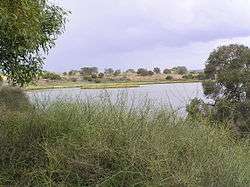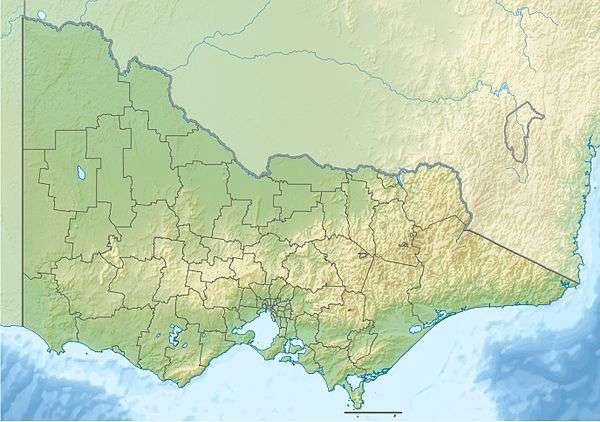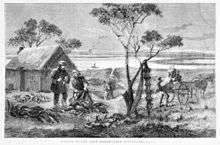Lake Connewarre
Lake Connewarre (Aboriginal Wathawurrung language: Kunawarr keelingk[2] literally meaning black swan lake), a shallow estuarine 880-hectare (2,200-acre) lake on the Barwon River, is located on the Bellarine Peninsula southeast of Geelong in the Australian state of Victoria.
| Lake Connewarre | |
|---|---|
 View of lake from Tait Point | |
 Lake Connewarre Location in Victoria | |
| Location | Bellarine Peninsula, Victoria |
| Coordinates | 38°13′29″S 144°27′21″E[1] |
| Type | Estuarine |
| Native name | Kunawarr keelingk |
| Primary inflows | Barwon River |
| Primary outflows | Barwon River |
| Basin countries | Australia |
| Surface area | 880 hectares (2,200 acres) |
| Average depth | 0.5–2 m (1 ft 8 in–6 ft 7 in) |
| References | [1][2][3][4] |
Location and features

It is adjacent to, and downstream from, the freshwater Reedy Lake. Lake Connewarre is linked to the sea by the mangrove-fringed channel of the lower Barwon River estuary, resulting in the lake being subject to tidal flows, with a weir at the inflow to the lake preventing saline water progressing upstream.
Lake Connewarre forms part of the Port Phillip Bay (Western Shoreline) and Bellarine Peninsula Ramsar Site as a wetland of international importance, with much of the wetland area also part of the Lake Connewarre State Game Reserve. However, most of the land surrounding Lake Connewarre has been cleared for agricultural purposes resulting in environmental degradation. Water pollution from upriver has also resulted in a drop in water quality, and reduced inflows to the lake have caused silting problems.[4] The lake is shallow being less than one metre in depth and generally unsuitable for boating.
Fauna
The lake and its associated wetlands are part of the Bellarine Wetlands Important Bird Area because of its conservation significance for several species of waders, waterbirds and the orange-bellied parrot.[5][6][7]
The lake is fished commercially for short-finned eel. It also usually contains yellow-eye mullet, black bream and Australian salmon. Other fish may be present, depending on salinity levels.
References
- "Lake Connewarre: 13372". Vicnames. Government of Victoria. 2 May 1966. Archived from the original on 2 June 2014. Retrieved 2 June 2014.
- "Lake Connewarre: 13372: Historical Information". Vicnames. Government of Victoria. 12 August 2011. Archived from the original on 6 June 2014. Retrieved 2 June 2014.
- "Map of Lake Connewarre, VIC". Bonzle Digital Atlas of Australia. Retrieved 2 June 2014.
- "Lake Connewarre Wildlife Reserve". Parks Victoria. Government of Victoria. Retrieved 2 June 2014.
- "IBA: Bellarine Wetlands". Birdata. Birds Australia. Archived from the original on 6 July 2011. Retrieved 6 June 2011.
- "Lake Connewarre State Game Reserve: Visitor Guide" (PDF). Parks Victoria (PDF). Government of Victoria. December 2010. Retrieved 2 June 2014.
- "Port Phillip Bay (Western Shoreline) and Bellarine Peninsula Ramsar Site: Park notes" (PDF). Parks Victoria (PDF). Government of Victoria. February 2012. Retrieved 2 June 2014.
External links
- Corangamite Catchment Management Authority
- "Lake Connewarre State Game Reserve" (PDF) (PDF map). Parks Victoria. Government of Victoria. 2011.